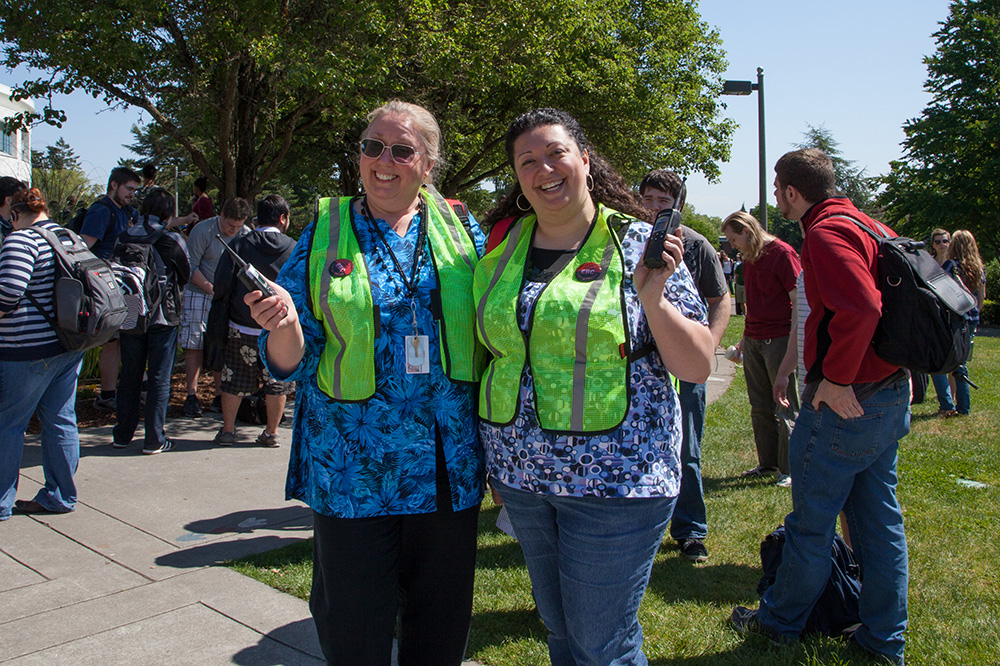
May 9, 2013 Clark College Evacuation Drill.
Clark College is committed to creating a safe learning environment for students, employees, and guests, but public safety is also the responsibility of each member of our community. Being prepared—both mentally and physically—for the unexpected is the first and best defense to minimize accidents, emergencies, and other incidents.
One aspect of Clark’s preparation efforts is the Emergency Management Planning Committee, which provides leadership, guidance, and solutions on safety and security issues. The committee recently welcomed Michael See, emergency manager, to the team. As a part of his role, See is responsible for helping to communicate emergency procedures to the college community.

Michael See
“In the recent campus climate survey, we found that many Clark employees felt less prepared and knowledgeable about emergency procedures than in previous survey periods,” said See. “We view this as an opportunity to provide further education, resources, and training to our community so that we all can be proactive participants in maintaining a safe environment.”
See, who was hired in November will be working over the summer to update Clark’s emergency procedures and the emergency-preparedness area of the Clark website, which can be accessed via www.clark.edu/emergency.
Small preparations, such as practicing emergency response procedures or knowing the location of designated Assembly Areas on campus, not only help keep us safe as individuals, but also contribute to the well-being of those around us.
Below, you will find guidance on emergency procedures, as well as links to resources and information on how to request additional training.
What is considered an emergency?
An emergency is any incident—caused by human or nature—that disrupts the standard operations of Clark College or its educational activities and requires immediate, responsive action. Large-scale emergencies can include natural disasters, facilities hazards such as fires or power outages, and acts or threats of violence.
How will I know when there is an emergency on campus?
Clark College has implemented a multi-tiered mass notification system to alert people on campus about emergencies. We have the ability to transmit emergency alerts through multiple methods including:
- The digital telephone system installed in most offices and classrooms
- Networked computer terminals
- Loudspeakers in many of the common areas
- Alerts sent to Clark College email
- Alerts posted to the college’s website
Faculty, staff and students can also opt-in to receive text alerts on their mobile devices by subscribing to RAVE, a no-cost service. All members of the Clark community are encouraged to sign up. Click the link for more information about Clark’s mass notification system.
What am I supposed to do?
If you discover an emergency, no matter the type, your first priority should be to ensure your own personal safety and the safety of those around you, to the best of your ability.
Once you are safe, notify Campus Security at extension 2133 for Main Campus or 6133 for CTC. Calling 911 may also be appropriate. Emergency Procedures posters, which are widely distributed across the campuses, and Emergency Response Guides, available in all work areas, provide specific directions based on the type of emergency.
Messages delivered through the mass notification system will also provide information about the nature of the emergency. More importantly, it will provide you with some instructions. The most common instructions you can expect will be to either lockdown or evacuate.
When directed to lockdown:
- Close and lock all doors and windows
- Close blinds or cover windows
- Leave all computers on and turn up the volume on all desk telephones
- Silence all cell phones, but leave them turned on
- When possible, turn off room lights
- Limit movement and be as quiet as possible until the “All Clear” message is transmitted through the mass notification system
When directed to evacuate:
- Leave your belongings where they are
- Walk in an orderly fashion towards the nearest exit, helping others that may need assistance, if you are able
- Each building has an Emergency Building Coordinator (EBC) assigned to guide people out safely; follow any instructions given by an EBC
- Move to a designated Assembly Area
- Wait for further instructions or an “All Clear” message
Clark College and the EMPC are committed to providing a safe environment for the entire college community. Michael See and the rest of the Clark College Emergency Management staff are available to address groups during meetings or other discussions upon request. Please contact emergencymanager@clark.edu to schedule or to submit specific questions or concerns.



